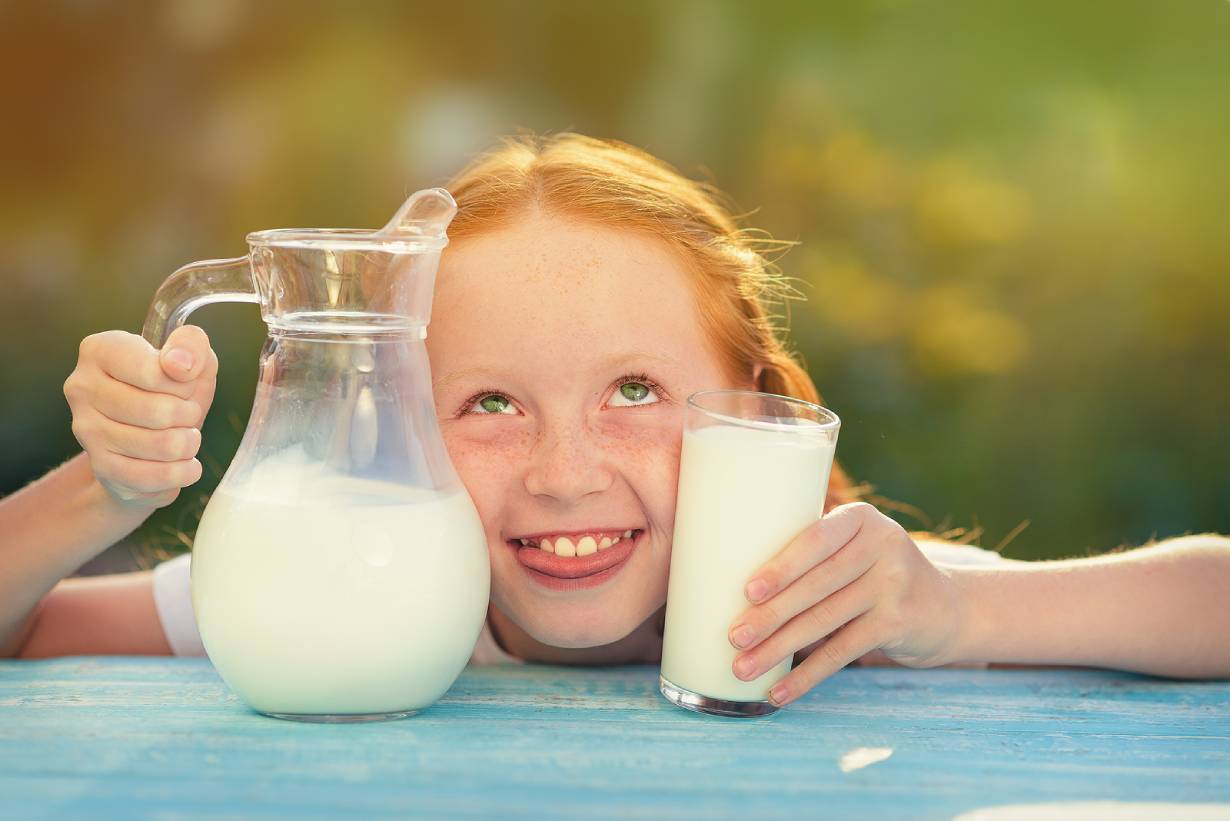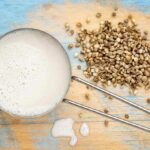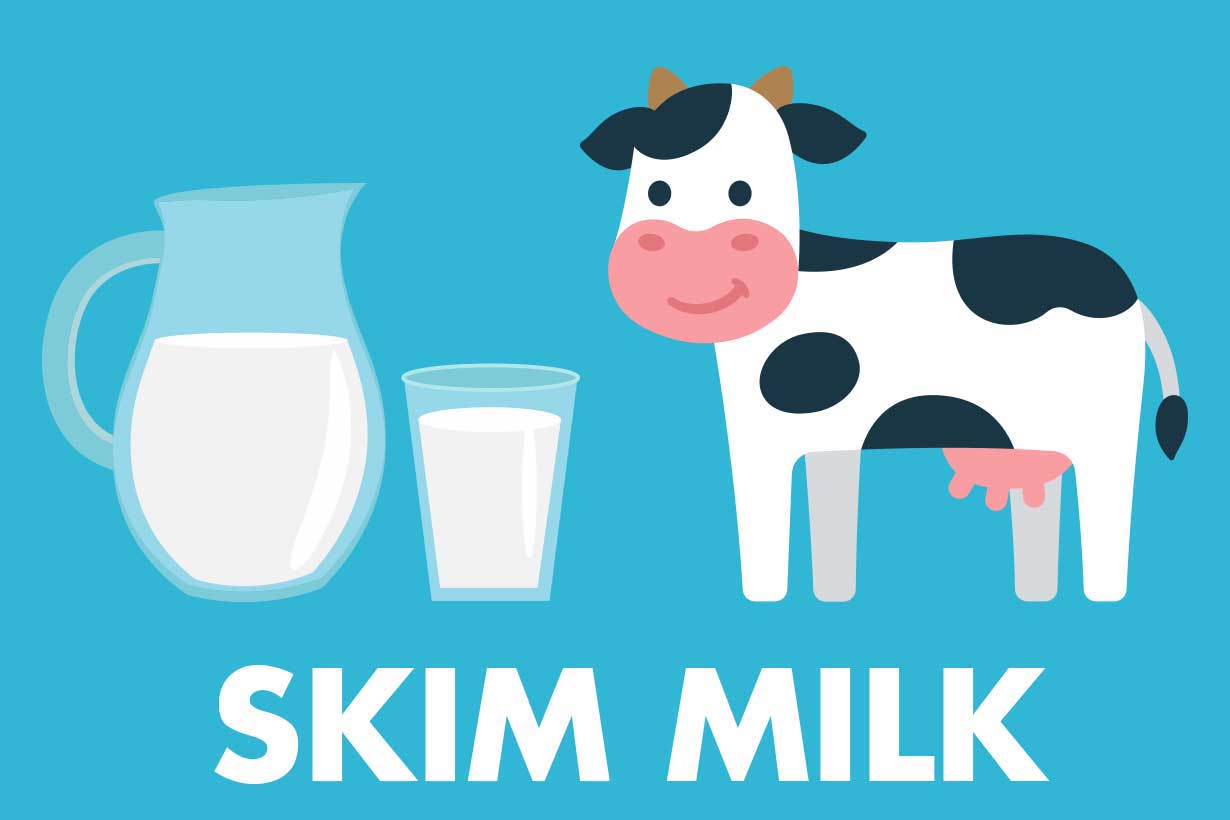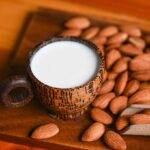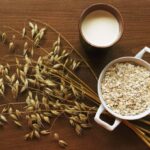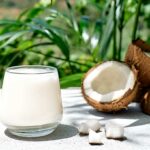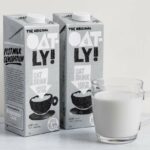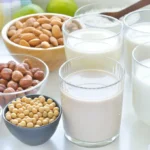There are many different types of milk available.
The available varieties include numerous types of dairy milk and plant-based milk options.
This article examines each common variety of milk and its nutritional values. We will also compare some of the pros and cons of the available options.
What Counts As Milk?
If we wish to define milk, among the various definitions within the Oxford English Dictionary, there are two of importance:
1a) “A whitish fluid, rich in fat and protein, secreted by the mammary glands of female mammals (including humans) for the nourishment of their young, and taken from cows, sheep, etc, as an article of the human diet.”
<Oxford English Dictionary, definition available here>
Definition 1a accurately describes dairy milk products, such as whole milk and buttermilk.
5a) “A culinary, pharmaceutical, cosmetic, or other preparation resembling milk, especially in colour. Usually with the principal ingredient or use specified by a preceding or following word.”
<Oxford English Dictionary, definition available here>
Definition 5a can refer to various plant-based milk options, including almond milk and soy milk.
Let’s now look at the available dairy and plant-based milk options and their nutritional properties.
Types of Dairy Milk
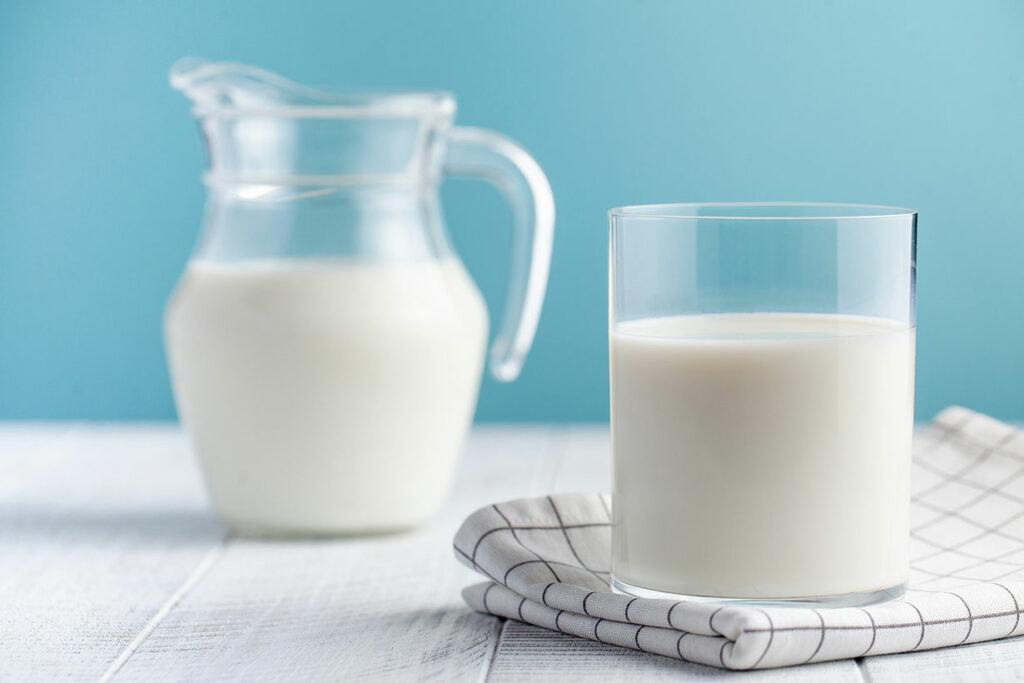
There is a wide range of dairy milk products, including milk of differing fat levels, flavored milk, and more.
1) Whole Milk
Whole milk refers to minimally adulterated milk that contains its original fat content.
Since it has a higher fat content than most other milk products, whole milk also contains more calories.
On the positive side, it has a fuller and creamier taste than reduced-fat options.
Whole milk is typically 3.25% milkfat within the United States, but this may change depending on the country.
For instance, whole milk in the United Kingdom has a milk fat content of 3.5% (1).
Here are the nutritional values for a regular 246-gram cup of whole milk (2):
- Calories: 149 kcal
- Carbohydrate: 11.7g
- Sugars: 11.7g
- Fat: 7.98g
- Saturated fat: 4.54g
- Monounsaturated fat: 1.98g
- Polyunsaturated fat: 0.47g
- Protein: 7.69g
- Protein per 100 calories: 5.16 grams
See here for an evidence-based guide to whole milk.
2) Reduced Fat Milk (2% Milk)
Reduced-fat milk has a 2% milkfat content.
Outside of the United States, in countries such as the United Kingdom and Australia, similar milk products may also take the name of ‘semi-skimmed milk.’
2% milk contains fewer calories than regular whole milk, and it tastes more like whole milk than milk options with even lower fat levels.
Per 245-gram glass serving, reduced-fat milk provides the following nutritional values (3):
- Calories: 125 kcal
- Carbohydrate: 12.2g
- Sugars: 12.2g
- Fat: 4.7g
- Saturated fat: 2.94g
- Monounsaturated fat: 1.36g
- Polyunsaturated fat: 0.17g
- Protein: 8.53g
- Protein per 100 calories: 6.82 grams
3) 1% Milk
As its name may suggest, 1% milk has a milkfat content of 1%.
As a result, the milk has a less creamy taste and contains significantly fewer calories.
A regular 245-gram cup of 1% milk has the following nutritional properties (4):
- Calories: 105 kcal
- Carbohydrate: 12.2g
- Sugars: 12.2g
- Fat: 2.38g
- Saturated fat: 1.48g
- Monounsaturated fat: 0.69g
- Polyunsaturated fat: 0.1g
- Protein: 8.53g
- Protein per 100 calories: 8.12 grams
4) Skim Milk
Skim milk is virtually fat-free and contains significantly fewer calories than reduced-fat milk options.
As a result, it tends to be an excellent protein source as the protein to calorie ratio is very high.
However, it has a much more watery consistency than whole milk, and it does not have a creamy taste. For this reason, many people find it doesn’t compare well in terms of taste.
The nutritional values per 245-gram cup of skim milk are as below (5):
- Calories: 83 kcal
- Carbohydrate: 12.2g
- Sugars: 12.2g
- Fat: 0.2g
- Saturated fat: 0.14g
- Monounsaturated fat: 0.05g
- Polyunsaturated fat: 0.01g
- Protein: 8.26g
- Protein per 100 calories: 9.95 grams
For more on skim milk and its nutritional properties, see this article.
5) Channel Island Milk
Channel Island milk refers to the milk produced by Jersey and Guernsey cattle breeds.
These breeds were originally from the Channel Islands, but they now produce milk in countries around the world.
Compared to milk from cattle that most milk comes from (Holstein Friesians), whole milk from Jersey and Guernsey cattle has a higher fat and protein content.
For this reason, the milk has a slightly thicker consistency and a much creamier taste.
One 245-ml cup of Channel Island milk will offer the following nutritional values (6):
- Calories: 194 kcal
- Carbohydrate: 11.27g
- Sugars: 11.27g
- Fat: 12.25g
- Saturated fat: 7.84g
- Protein: 9.8g
- Protein per 100 calories: 5.05 grams
6) Chocolate Milk
While there are many different flavored milk options, chocolate milk is arguably the most common option.
Interestingly, chocolate milk provides a slightly higher amount of minerals than regular milk due to its cocoa content (7).
Although the ingredients can vary, chocolate milk is usually a combination of dairy milk, cocoa powder, sugar, and sometimes thickeners.
A 250-ml cup of chocolate milk offers these nutritional values (7):
- Calories: 208 kcal
- Carbohydrate: 25.8g
- Sugars: 23.8g
- Fat: 8.48g
- Saturated fat: 5.25g
- Monounsaturated fat: 2.48g
- Polyunsaturated fat: 0.31g
- Protein: 7.92g
- Protein per 100 calories: 3.81 grams
See this in-depth guide to chocolate milk for more information.
7) Half and Half
Half and half is a combination of whole milk and cream.
As the name implies, half and half contains 50% whole milk and 50% cream.
Half and half is often used in the kitchen for making soups and sauces rather than being for drinking.
The product can be a good compromise when cream is too heavy, and milk is too light for a particular dish or usage.
A regular 242-gram cup of half and half has the following nutritional profile (8):
- Calories: 317 kcal
- Carbohydrate: 10.4g
- Sugars: 10g
- Fat: 27.8g
- Saturated fat: 17.0g
- Monounsaturated fat: 8.03g
- Polyunsaturated fat: 1.34g
- Protein: 7.58g
- Protein per 100 calories: 1.20 grams
8) Ultra-high Temperature Milk (UHT)
Ultra-high temperature milk is regular milk that has gone through a pasteurization process at an ultra-high temperature.
According to the International Dairy Foods Association (IDFA), this temperature must be 138ºC (280ºF) or above for at least 2.0 seconds (9).
Notably, UHT-processed milk still has the same nutritional properties as regular milk. However, it has a much longer shelf-life of approximately 30 to 90 days when refrigerated (10).
When tested by a trained sensory panel, the panel noted that UHT milk had “distinct cooked and sulfur flavors” compared with regular milk (11).
The nutritional profile of UHT milk will depend on the type (whole/reduced fat/fat-free) of milk.
9) Lactose-free Milk
The name of the primary sugar in milk is lactose.
However, much of the world’s population is lactose-intolerant. This means that regular milk can cause digestive symptoms in many people (12).
For this reason, lactose-free varieties of milk are available.
Notably, “lactose-free milk” still contains lactose, but producers add an enzyme called lactase to it. Lactase is the enzyme that helps break lactose down, which people with lactose intolerance do not produce in sufficient quantities (13).
Once again, the specific nutritional values of lactose-free milk can differ depending on the type of milk (whole/skim).
That said, here are the nutritional values of lactose-free whole milk per 244-gram cup (14):
- Calories: 146 kcal
- Carbohydrate: 11.7g
- Sugars: 11.7g
- Fat: 7.81g
- Saturated fat: 4.54g
- Monounsaturated fat: 1.68g
- Polyunsaturated fat: 0.26g
- Protein: 8g
- Protein per 100 calories: 5.48 grams
10) Buttermilk
Buttermilk is a drink made from the bacterial fermentation of milk using a lactic acid-producing culture (15).
Compared to milk, buttermilk has a thicker consistency and a slightly sour taste.
However, buttermilk is very close to regular milk in nutritional value.
Here are the nutritional properties for buttermilk made from whole milk, per 245-gram cup (16):
- Calories: 152 kcal
- Carbohydrate: 12g
- Sugars: 12g
- Fat: 8.11g
- Saturated fat: 4.66g
- Monounsaturated fat: 2.03g
- Polyunsaturated fat: 0.49g
- Protein: 7.86g
- Protein per 100 calories: 3.6 grams
See this guide for more information on buttermilk.
11) Evaporated Milk
Evaporated milk is a sweet milk-based drink, often used with cakes and other desserts.
Despite being sweet, evaporated milk contains no added sugar or additional ingredients.
Instead, the production process involves heating milk and letting some of the water content evaporate from it.
The result is that evaporated milk has a thicker consistency and double the sugar content of regular milk. Thus, it has a sweeter taste (17).
Since the water content of evaporated milk is much lower, it also has higher protein, fat, and calorie levels.
A 252-gram of evaporated milk provides the following nutritional values (18).
- Calories: 338 kcal
- Carbohydrate: 25.2g
- Sugars: 25.2g
- Fat: 19.1g
- Saturated fat: 11.6g
- Monounsaturated fat: 5.9g
- Polyunsaturated fat: 0.62g
- Protein: 17.2g
- Protein per 100 calories: 5.09 grams
See this full guide to evaporated milk for more information
12) Goat Milk
While most commercial milk comes from cattle, goat milk is a relatively common alternative.
Some people feel there is a difference in taste, with “grassy” being one common descriptor, but others find it hard to notice any difference.
The nutritional differences are minimal, too; the values per 244-gram cup of whole goat milk are below (19):
- Calories: 168 kcal
- Carbohydrate: 10.9g
- Sugars: 10.9g
- Fat: 10.1g
- Saturated fat: 6.52g
- Monounsaturated fat: 2.71g
- Polyunsaturated fat: 0.36g
- Protein: 8.69g
- Protein per 100 calories: 5.17 grams
Find out more about goat milk here.
13) Milk Powder (Whole Milk)
Milk powder (sometimes known as powdered milk) is produced from an evaporation process that removes all the liquid from milk.
Since it has no water content, the remaining milk powder has a much higher nutrient density.
Milk powder has multiple uses, and it is used in baby formulas, food production (e.g. milk chocolate), and baking.
Per 100 grams, whole milk powder has the following nutritional profile (20):
- Calories: 387 kcal
- Carbohydrate: 49g
- Sugars: 49g
- Fat: 5.78g
- Saturated fat: 3.6g
- Monounsaturated fat: 1.67g
- Polyunsaturated fat: 0.22g
- Protein: 34.3g
- Protein per 100 calories: 8.86 grams
14) Milk Powder (Skim Milk)
Compared to whole milk powder, milk powder made from skim milk has less fat and calories.
Gram-for-gram skim milk powder also contains more protein and carbohydrates.
Here are the nutritional values per 100 grams of skim milk powder (21):
- Calories: 360 kcal
- Carbohydrate: 52g
- Sugars: 52g
- Fat: 0g
- Saturated fat: 0g
- Protein: 36g
- Protein per 100 calories: 10.0 grams
15) Condensed Milk
The process of making condensed milk is the same as evaporated milk.
When heating milk, some of the water evaporates, and the remaining milk becomes more concentrated.
However, condensed milk usually contains large amounts of added sugar, making it even sweeter.
A typical 304-gram cup of condensed milk has the following nutritional values (22):
- Calories: 976 kcal
- Carbohydrate: 165g
- Sugars: 165g
- Fat: 26.4g
- Saturated fat: 16.7g
- Monounsaturated fat: 7.39g
- Polyunsaturated fat: 1.02g
- Protein: 24g
- Protein per 100 calories: 2.46 grams
Types of Plant-Based Milk
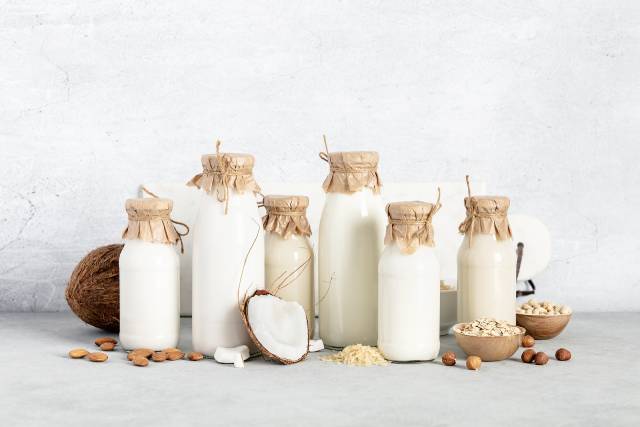
Plant milk can come from various foods, including grains, nuts, and seeds.
There are dozens of plant milk varieties, but this guide will focus on the most common options.
Please note: plant-based milks are not naturally a source of calcium or vitamin B12, so it’s important to check if they have been fortified. For more information, see this guide to the amount of calcium in milk alternatives.
1) Almond Milk
Almond milk is the product of almonds and water, and it is available in sweetened and unsweetened forms.
Some almond milk products are also fortified with nutrients such as calcium, iodine, vitamin B12, and vitamin D.
However, this fortification (and the amount) will vary from brand to brand.
Almond milk is the most popular nut-based milk, and it has a light and nutty taste. It is also probably the lowest calorie variety of milk.
According to the USDA FoodData Central nutrition database, a 262-gram cup of unsweetened almond milk provides (23):
- Calories: 39 kcal
- Carbohydrate: 3.43g
- Sugars: 2.12g
- Fat: 2.52g
- Saturated fat: 0.21g
- Monounsaturated fat: 1.55g
- Polyunsaturated fat: 0.63g
- Protein: 1.05g
- Protein per 100 calories: 2.67 grams
As we can see, unsweetened almond milk is low in calories, carbohydrates, and fat compared to dairy milk.
However, it is not a good alternative for its protein content.
See this full guide to almond milk for more information
2) Cashew Milk
Cashew milk is another popular plant milk produced from nuts.
However, the nutrition profile is quite different from almond milk.
Here are the nutritional values for a 240-ml cup of unsweetened cashew milk (24):
- Calories: 130 kcal
- Carbohydrate: 7.01g
- Sugars: 1.01g
- Fat: 10g
- Saturated fat: 1.49g
- Protein: 4.01g
- Protein per 100 calories: 3.08 grams
As shown, cashew milk has similar calories as whole dairy milk. However, it contains more fat and fewer carbohydrates and protein.
3) Coconut Milk
Coconut milk is slightly different from the other kinds of plant milk available.
For one thing, it has been available a lot longer, and it has been a traditional food ingredient for centuries in South-East Asia.
Additionally, regular coconut milk tends to be used in soups and curries rather than as a milk alternative.
That said, the light variety of coconut milk can also work in drinks like coffee.
Light coconut milk has a high fat content and provides minimal protein.
Per 244-gram cup, coconut milk has these nutritional values (25):
- Calories: 231 kcal
- Carbohydrate: 7.1g
- Sugars: 6.1g
- Fat: 5.08g
- Saturated fat: 5.08g
- Monounsaturated fat: 0g
- Polyunsaturated fat: 0g
- Protein: 0.51g
- Protein per 100 calories: 0.22 grams
See this article for a complete nutritional guide to coconut milk
4) Hazelnut Milk
Hazelnut milk has a significantly lower carbohydrate content than other nut-based milk products.
Regarding its taste profile, hazelnut milk is very mild and has a slightly nutty flavor.
Per 240-ml cup, the nutritional values for unsweetened hazelnut milk are as follows (26):
- Calories: 91 kcal
- Carbohydrate: 1.01g
- Sugars: 6.1g
- Fat: 9g
- Saturated fat: 0.5g
- Monounsaturated fat: 0g
- Polyunsaturated fat: 0g
- Protein: 1.99g
- Protein per 100 calories: 2.19 grams
5) Hemp Milk
Hemp milk is a relatively new but popular plant milk option.
Despite being a seed, milk made from hemp tends to have a nutty taste similar to other kinds of nut milk.
The flavor is mild, and it has a thicker/creamier consistency than many plant milk options.
While the protein content of hemp milk doesn’t quite match dairy milk, it is higher than other nut milk varieties.
A 257-gram cup serving of hemp milk has the following nutrition profile (27):
- Calories: 101 kcal
- Carbohydrate: 7.2g
- Sugars: 6.2g
- Fat: 6.8g
- Saturated fat: 0.6g
- Protein: 4.4g
- Protein per 100 calories: 4.36 grams
For a complete nutritional guide to hemp milk, please refer to the following article:
Hemp Milk: Nutritional Values, Benefits, Downsides
6) Oat Milk
Oat milk is the most popular type of milk produced from grains.
Also, it is the second most popular plant-based milk in the United States after almond milk (28).
Oat milk has a medium-thick consistency, but it is not as thick or creamy as whole dairy milk.
It has a light, oaty, and somewhat nutty taste, and it is lower in fat and higher in carbohydrate than many kinds of plant milk.
A typical 240-ml cup serving of unsweetened oat milk has the following nutrition profile (29):
- Calories: 115 kcal
- Carbohydrate: 12.2g
- Sugars: 5.57g
- Fat: 6.6g
- Protein: 1.92g
- Protein per 100 calories: 1.67 grams
For a comprehensive guide to oat milk, please refer to this article covering its benefits and downsides:
Is Oat Milk Good or Bad For You?
It should also be noted that, while oats don’t naturally contain gluten, oat milk can be a source of it.
See here for more information: Is Oat Milk Gluten-Free?
7) Pea Milk
Unlike many types of plant-based milk, pea milk is a rich source of protein.
An unsweetened 240-ml cup of pea milk has the following nutrition profile (30):
- Calories: 70 kcal
- Carbohydrate: 0g
- Sugars: 0g
- Fat: 4.51g
- Saturated fat: 0.50g
- Protein: 7.99g
- Protein per 100 calories: 11.41 grams
8) Rice Milk
Rice milk is relatively bland and mild and has no strong flavors.
However, it has a mild sweetness due to its high carbohydrate content.
Rice milk contains very low amounts of protein and fat.
Here is the nutritional profile for one 240-ml cup of unsweetened rice milk (31):
- Calories: 113 kcal
- Carbohydrate: 22g
- Sugars: 12.7g
- Fat: 2.33g
- Saturated fat: 0g
- Monounsaturated fat: 1.5g
- Polyunsaturated fat: 0.75g
- Protein: 0.67g
- Protein per 100 calories: 0.59 grams
9) Soy Milk
Soy milk is one of the oldest plant-based milk varieties and one of the most popular.
In the United States, it is the third most popular plant-based milk behind almond milk and oat milk (32).
Soy milk has a mildly sweet flavor, and many people seem to enjoy the taste.
Here are the nutritional values for a 240-gram cup of unsweetened soy milk (33):
- Calories: 91 kcal
- Carbohydrate: 3.1g
- Sugars: 1.34g
- Fat: 5.09g
- Saturated fat: 0.75g
- Monounsaturated fat: 0.99g
- Polyunsaturated fat: 2.76g
- Protein: 8.52g
- Protein per 100 calories: 9.07 grams
Nutritional Comparison Table For Each Type of Milk
The following table presents the nutritional values per cup of each (liquid) milk in this guide for easy at-a-glance comparison.
| Name | Calories | Carbs | Sugar | Fat | Sat Fat | Protein | Protein/100 kcal |
|---|---|---|---|---|---|---|---|
| Whole milk | 149 | 11.7g | 11.7g | 7.98g | 4.54g | 7.69g | 5.16g |
| Reduced-fat milk | 125 | 12.2g | 12.2g | 4.7g | 2.94g | 8.53g | 6.82g |
| 1% milk | 105 | 12.2g | 12.2g | 2.38g | 1.48g | 8.53g | 8.12g |
| Skim milk | 83 | 12.2g | 12.2g | 0.2g | 0.14g | 8.26g | 9.95g |
| Channel island milk | 194 | 11.27g | 11.27g | 12.25g | 7.84g | 9.8g | 3.05g |
| Chocolate milk | 208 | 25.8g | 23.8g | 8.48g | 5.25g | 7.92g | 3.81g |
| Half and half milk | 317 | 10.4g | 10g | 27.8g | 17.0g | 7.58g | 1.20g |
| Buttermilk (whole) | 152 | 12g | 12g | 8.11g | 4.66g | 7.86g | 3.6g |
| Evaporated milk (whole) | 338 | 25.2g | 25.2g | 19.1g | 11.6g | 17.2g | 3.09g |
| Goat milk (whole) | 168 | 10.9g | 10.9g | 10.1g | 6.52g | 8.69g | 5.17g |
| Condensed milk (whole) | 976 | 165g | 165g | 26.4g | 16.7g | 24g | 2.46g |
| Almond milk | 37 | 3.2g | 1.98g | 2.34g | 0.20g | 0.98g | 2.67g |
| Cashew milk | 130 | 7.01g | 1.01g | 10g | 1.49g | 4.01g | 3.08g |
| Coconut milk | 231 | 7.1g | 6.1g | 5.08g | 5.08g | 0.51g | 0.22g |
| Hazelnut milk | 91 | 1.01g | 6.1g | 9.0g | 0.5g | 1.99g | 2.19g |
| Hemp milk | 101 | 7.2g | 6.2g | 6.8g | 0.6g | 4.4g | 4.36g |
| Oat milk | 115 | 12.2g | 5.57g | 6.6g | – | 1.92 g | 1.67g |
| Pea milk | 70 | 0g | 0g | 4.51g | 0.50g | 7.99g | 11.41g |
| Rice milk | 113 | 22g | 12.7g | 2.33g | 0g | 0.67g | 0.59g |
| Soy milk | 91 | 3.1g | 1.34g | 5.09g | 0.75g | 8.52g | 9.07g |
Important Considerations If Choosing a Plant-Based Milk
Here are some crucial points to consider if opting for plant-based milk.
- Various plant milks are on the market and they are designed to mimic the appearance and uses of dairy milk. However, they are not always comparable nutritionally.
- Most plant milks offer a lot less protein than dairy milk. If protein is important, soy milk and pea milk are the best plant-based options.
- Dairy milk contains a wide variety of nutrients, including calcium, iodine, vitamin B12, and vitamin D. Not all plant milk options will provide equivalent amounts of these important nutrients – check the package label as it will vary from brand to brand and depend on fortification.
Final Thoughts
This article shows just how many different milk options are available for consumers.
However, they are not all like-for-like options.
For this reason, it is vital to be aware of the nutritional differences if particular nutrients are of importance.
If choosing plant-based milk, finding a product fortified with essential nutrients such as calcium, iodine, vitamin B12, and vitamin D is a good idea.
In contrast, if taste is the primary consideration, it is just a matter of choosing the preferred type of milk.

